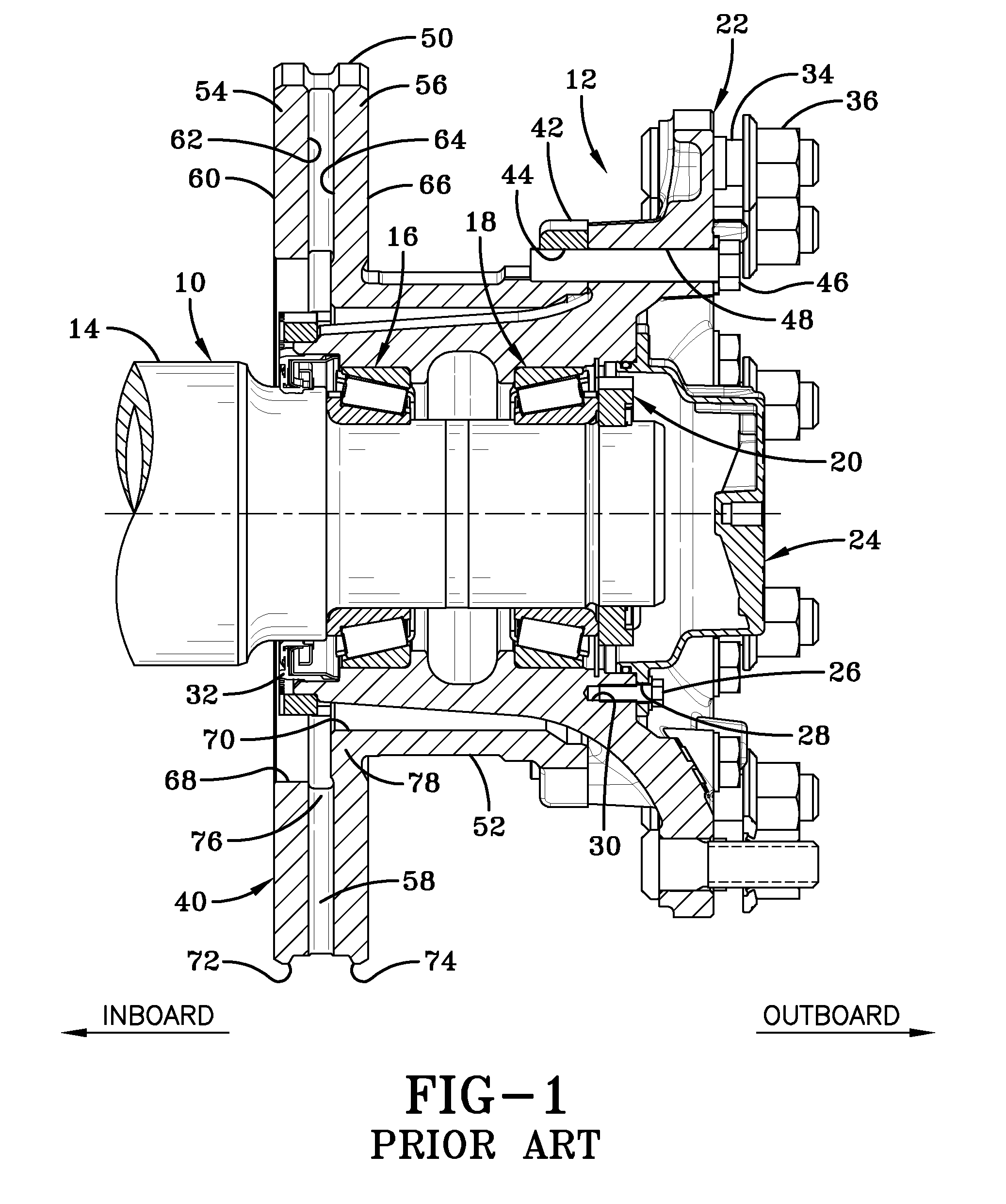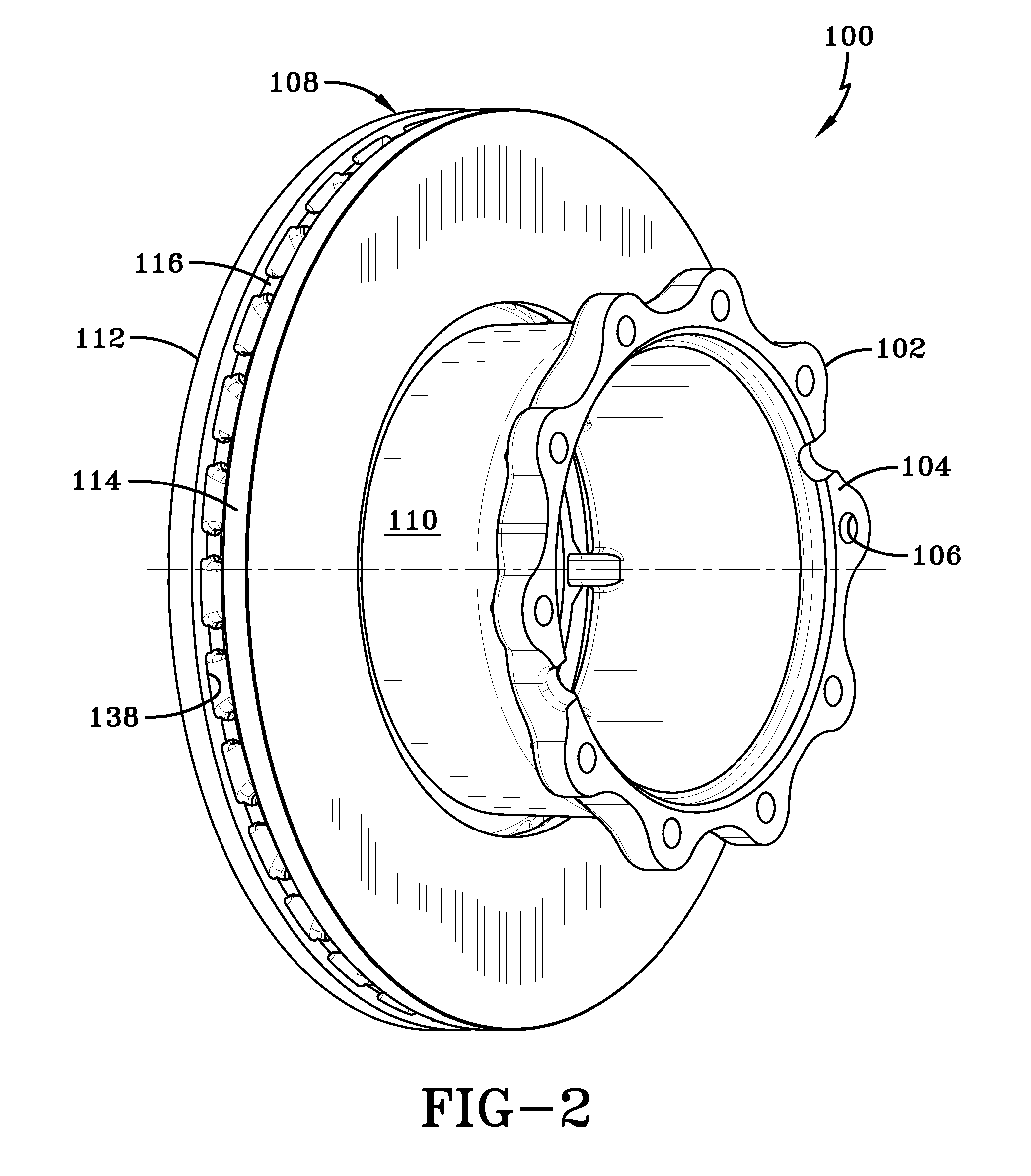Disc brake rotor for heavy-duty vehicles
a disc brake and rotor technology, applied in the direction of brake types, brake discs, mechanical devices, etc., can solve the problems of significant thermal stress on the disc portion of the rotor, reduce the performance and life of the rotor, and significant heat, etc., and achieve the effect of increasing air flow
- Summary
- Abstract
- Description
- Claims
- Application Information
AI Technical Summary
Benefits of technology
Problems solved by technology
Method used
Image
Examples
first embodiment
[0057]the improved disc brake rotor for heavy-duty vehicles of the present invention is indicated generally at 100 and is shown in FIGS. 2-7. As will be described in detail below, rotor 100 of the present invention includes an inboard attachment to a rotor sleeve and thus to a hub of a wheel end assembly, which reduces coning of the rotor during braking. Rotor 100 of the present invention also includes pins that interconnect inboard and outboard discs of the rotor, which increase air flow between the discs beyond that of prior art vane-type connections. Moreover, rotor 100 of the present invention includes an improved metallurgical composition that desirably maintains the heat transfer properties of the rotor while decreasing the brittleness of the rotor and improving the hot strength of the rotor. These features cooperate to improve the resistance of rotor 100 to thermal stress created during braking, thereby increasing the performance and the life of the rotor, and also increasing...
second embodiment
[0079 rotor 160, by employing pins 116′, increases air flow through rotor disc portion 108′, which dissipates heat and reduces thermal loading of the disc portion.
[0080]Reduction of thermal loading of rotor disc portion 108′ reduces potential cracking of rotor 160, thereby improving the performance and the life of the rotor. In addition, pins 116′ create a discontinuous radial connection between inboard disc 112′ and outboard disc 114′, compared to continuously connected radially-extending vanes 58 of the prior art. In the event a crack forms on inboard disc 112′ and / or outboard disc 114′, the discontinuous radial connection created by pins 116′ acts to prevent propagation of the crack, thereby further improving the performance and the life of rotor 160.
[0081]Referring now to FIGS. 11 and 12, a third embodiment of the improved disc brake rotor for heavy-duty vehicles of the present invention is shown and indicated generally at 170. Third embodiment rotor 170 is similar in structure ...
fourth embodiment
[0092 rotor 220 thus may be formed to accept a discrete tone ring 180, which may be formed of a different material than the rotor. Use of a discrete tone ring 180 reduces corrosion issues in particular circumstances, enables the tone ring to be removed for servicing, and desirably reduces weight when compared to integrally-formed tone ring 152 (FIG. 4).
[0093]In this manner, the construction and arrangement of the improved disc brake rotor 100, 160, 170, 220 for heavy-duty vehicles of the present invention provides an inboard connection 140, 140′, 140″, 140′″ of disc portion 108, 108′, 108″, 108′41 to sleeve 110, 110′, 110″, 110′″, which reduces or eliminates coning of the disc portion due to the heat from braking. Such a reduction or an elimination of coning optimizes the efficiency of the brake system, and desirably reduces the stress at each point of contact between the brake pads and each respective inboard disc 112, 112′, 112″, 112′″ and outboard disc 114, 114′, 114″, 114′″. Th...
PUM
| Property | Measurement | Unit |
|---|---|---|
| diameter | aaaaa | aaaaa |
| diameter | aaaaa | aaaaa |
| diameter | aaaaa | aaaaa |
Abstract
Description
Claims
Application Information
 Login to View More
Login to View More - R&D
- Intellectual Property
- Life Sciences
- Materials
- Tech Scout
- Unparalleled Data Quality
- Higher Quality Content
- 60% Fewer Hallucinations
Browse by: Latest US Patents, China's latest patents, Technical Efficacy Thesaurus, Application Domain, Technology Topic, Popular Technical Reports.
© 2025 PatSnap. All rights reserved.Legal|Privacy policy|Modern Slavery Act Transparency Statement|Sitemap|About US| Contact US: help@patsnap.com



